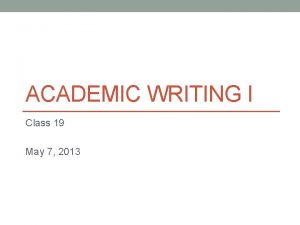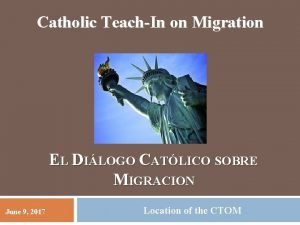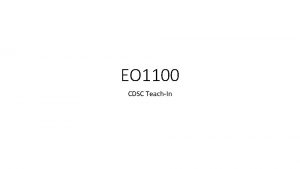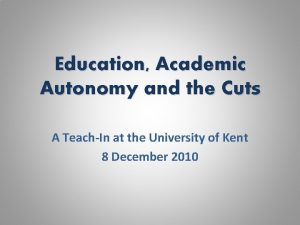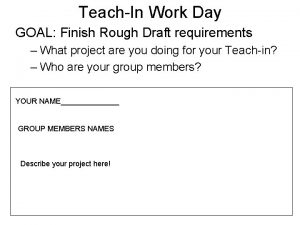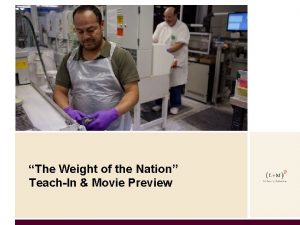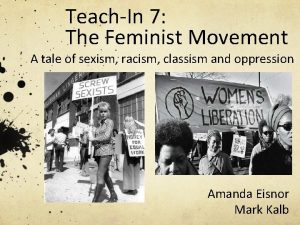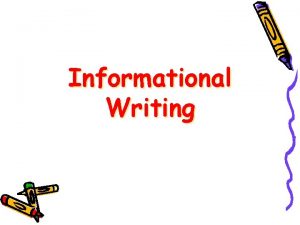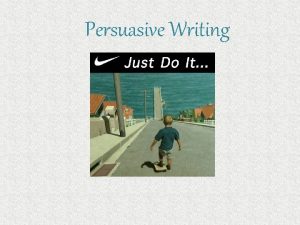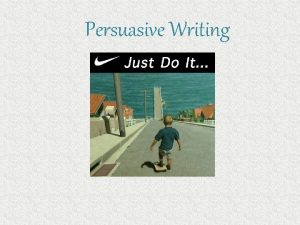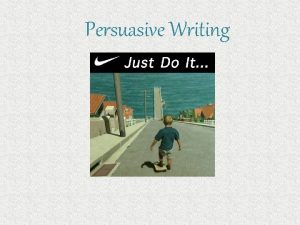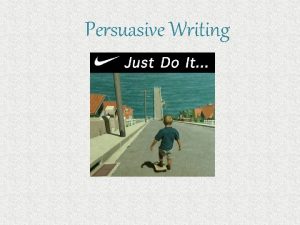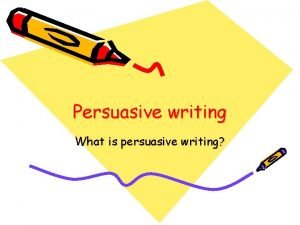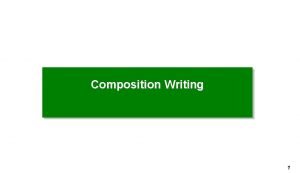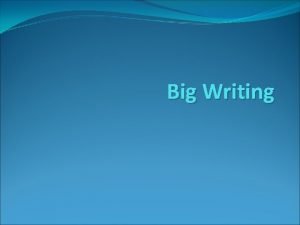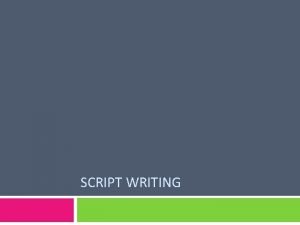Teachin g writing Writing v Writing is the










































- Slides: 42

Teachin g writing

Writing v. Writing is the ability to express one’s ideas in written form in a second or foreign language and to do so with reasonable accuracy and coherence. v. The view of writing as an act communication suggests an interactive process which takes place between the writer and the reader via the text. Such an approach places value on the goal of writing as well as on the perceived reader audience.

Objectives of Teaching Writing 1)To familiarize students with the directed, controlled and free compositions. 2)To train students in schools to practise writing in English on proper footing. 3)To enable students to express their ideas adequately while using the English language. 4)To involve students in various drills in letter writing.

5) To acquaint students with a variety of steps in writing composition. 6) To familiarize students with steps in writing compositions and letters. 7) To involve students in practice to correct returned composition material using correction symbols.

Procedures in Teaching Composition 1. Presentation of the composition: 1) The language teacher should discuss type of composition assignment. He should also explain the idea, content, model and procedure of the composition.

2) The language teacher should clear up any difficulty in linguistic rule. He should explain briefly the grammatical structures necessary for writing the assignment, particularly the controlled composition. 3) He should be certain that students understand the assignment, the directions and the instructions. 4) He should engage the entire class in the composition writing activity.

2. Writing of the composition A. The EFL teacher should ask his students to write on lined paper of a standard size. B. He should ask them to write on every other line and to leave ample room for corrections. C. He should instruct them to write legibly and clearly. Sloppy and careless work is not accepted. The hand written composition should be neat. There should be no crossouts, crowded letters and ink blots on the

D. He should allow students to ask questions to facilitate writing. He should provide them with list of vocabulary if they ask for it. E. He should be encouraging and stimulating to improve the standard level of writing compositions.

3. Correction of the composition A. The teacher should give periodic and systematic feedback on the students’ writing. All vocabulary, grammar and style mistakes should be indicated and the correct form should be supplied. B. The teacher and students should be familiar with the correction symbols for common mistakes. A list of symbols with their explanations and examples in text are prepared to facilitate proofreading, editing or correction.

C. The teacher can summarize the major rules of punctuation, capitalization and spelling for his students. He should give them an outline of these rules in the beginning of the term. D. The teacher should review or discuss again the patterns which constitute a general mistake or problem for most of the students.

E. The teacher should firmly ask his students to do the corrections. He should not record the grade or mark for the written composition in their notebooks unless the students have already done the corrections.

Techniques in Teaching Composition 1. Techniques in Controlled Composition: There are several techniques in teaching controlled composition. 1) The language teacher asks his students to make changes in a particular grammatical item in a given passage, for example, to modify its tense to past. 2) The language teacher asks his students to make relative changes as a result of a modification in a grammatical feature such as pronouns.

3) The language teacher gives a variety of acceptable alternative-words to his students to select and substitute. 4) The language teacher write pairs or sets of sentences on the board asking his students to combine them to form a single sentence, without using “and” or “but”. 5) The language teacher gives general modifiers, i. e. adjectives and adverbs which qualify or limit the meanings of nouns and verbs respectively, asking his students to insert the appropriate one in the place of each number or in the proper place.

6) The language teacher gives a list of transition words, i. e. , linking words, asking his students to select an appropriate one in place of each number. Students may also be asked to use connectives as transitional expressions in the paragraph. Connectives include: furthermore, however, moreover, nevertheless, and therefore. 7) The language teacher provides sentences in two column asking his students to link the statements in column

8) The language teacher reorders the sentences within the paragraph or paragraphs in a longer discourse. He then asks his students to redevelop the original in a logical sequence. 9) Students are asked to reduce certain clauses to phrases and phrases to single words. Ex: § After she has arrived from Jeddah. (clause)

2. Techniques in Teaching Directed Composition A- Students are asked to conduct real or imaginary written interviews with their classmates. They should decide about the nature of the information to be obtained. Students might prepare an application form about the background information of the interviewee, e, g. nationality, age, education, experience, family size. It may also include a survey of other activities of interest and course preference.

B. Students are asked to make a written description of the items in the picture including locations, shapes, sizes and colors. The teacher can write necessary words and expressions on the board to help his students write useful and meaningful information. C. The language teacher divides his class into pairs of students. In each pair, he gives one of the students a picture, asking him to write a description thereof and then give it to his companion who will draw it. Finally students collaboratively make lists of similarities and dissimilarities between the written description and the drawing.

D. The writing teacher develops a list of questions about a particular picture, asking his students to write complete answers to them. Then, students are instructed to put these sentences together to form a paragraph. Students may need to use combining exercises while developing the passage. E. Students are asked to discuss, describe and explain in a written form a series of objects in the class. These descriptions should be so concise and accurate that they will distinguish the items under discussion from all other relevant ones. The teacher can, for instance, ask group “A” to describe the items: board, chairs and desks, whereas group “B” may be asked to identify:

F. Students can write lists of words, for example, about items they should prepare for their picnic, shopping list, list of things to do tomorrow, list of people to invite to a party, list of places to visit and so on. Students first, list the names of the items and then classify them into specific categories. These categories include clothing, food, kitchen articles, and sport items, etc. Finally, students use these categories while writing a paragraph. G. The teacher tells a story to his class and then asks them to repeat it in writing. H. Students are asked to take notes on lectures and on formal discussions.

I. The teacher writes or tells an incomplete story, dialogue, event, or personal experience to his class asking them to complete it in a written form. J. The language teacher writes a story on the board asking his students to use it as a model in writing a creative one beginning with a similar introduction.

K. The language teacher reads a short paragraph or a story aloud several times asking his class to answer the comprehension questions based on it. He then repeats it and lists several key words on the board. Using these words as cues, the students should try to rewrite the story or paragraph in meaningful and complete manner. Teacher should check it and indicate errors, gaps and sequence problems.

L. Students are asked to make a variety of simple and meaningful sentences which are put on the board. Students are encouraged to consider these sentences and try to combine them in any way to form a coherent passage in a written form. Students can work individually or collectively in this activity. M. Students are given an “advertisement” from a magazine asking them to describe it in a form of a letter writing to a friend.

N. The teacher gives a particular diagram to each student in a pair asking him to write instructions on how to create it and to redraw the diagram. Then they make a comparison between theirs and the original. These instructions may include how to prepare a particular dish, how to write a coherent paragraph in the target language, how to behave with your parents.

O. The teacher gives students in pairs a table. Students discuss in a written form all the information the table contains. Similarities and dissimilarities between figures and items may be stated and considered in the written description. P. The teacher gives his students a piece of written literature/history asking them to summaries and / or to paraphrase it

Q. The teacher asks students to prepare a dialogue from a narrative paragraph and vice versa i. e. , a narrative paragraph from a dialogue. R. Students are asked to look at the two maps of countries, cities, and streets on the board. They read a paragraph about one of them. Then they are asked to use that paragraph as a model to write a similar one about another country.

S. Students are asked to give clear directions in the written form on how to move from one place to another on the map. The teacher may help students with some spatial expressions such as straight ahead, turn right, at the corner, at the second block, etc. T. The teacher shows samples of a variety of letter-writing types, i. e. letters of invitation, intimate apology, business, official, complaint, application, inquiry, thanks and congratulation. In doing so they are given a full explanation about the mechanics and the format of writing a letter.

C. Techniques in Free Composition In independent composition, creativity is encouraged. A. Students are asked to make a special diary to state in English their feelings, events, activities and reaction to incidents they get involved in on a particular day. Correcting and grading are not recommended to encourage fluency.

B. The language teacher asks his students to write a paragraph in the target language at the end of the class period about what was covered and what happened in the class. Students might write about attendance, subject matter, types of activities, mood of the teacher and students and give general comments and reaction. C. Students are asked to write an inquiry report or essay about any topic suggested by the EFL teacher.

D. A writing teacher may ask his students to compose a letter of a particular type, i. e. personal letter, business letter, official letter, or a complaint letter. Students are not given a model to use in their writing. The teacher may only draw their attention to the appropriate format and layout of writing a letter.

E. Students are asked to write about their wishes, fears, and troubles in life. Feelings, naturally, stimulate creative writing. Students are encouraged to express such feelings, by clearing out any difficulty in the selection of vocabulary and structure. F. Students are provided with a variety of titles and then asked to write on one of them. Such titles of writing material might be like this:

§ Lucky Boy § Fire! § A Lost Child § Help! § Adventure at night § Childhood fears § Easy come Easy go

Steps in Writing Composition Step 1 : choosing the composition A. Select an interesting subject. B. Limit the scope of your subject to a specific topic. Step 2 : Assembling materials A. Ask students to make a list of ideas about the subject you propose for writing. B. Ask them to review the list of their ideas and eliminate the unrelated or

Step 3 : Writing an outline A. Ask them to write the title of the subject in the center at the top. B. Show them how to classify the related ideas into groups according to their similar characteristics and general concepts. C. Help them arrange these groups of ideas in a meaningful and logical way.

D. Show them how to outline ideas. E. Ask students to start with an outline of the largest and salient ideas and proceed to smaller and less ones. F. Help students to organize and present their ideas effectively and logically in written form.

Step 4 : Writing and revising the paragraph of the first draft A. Ask students to compose their ideas clearly and put them in a logical order in a paragraph. Each paragraph should discuss only one topic which is stated in the topic sentence. Sentences in the paragraph should flow and be related to one another smoothly. B. In the first draft, ask them to ignore problems and errors in spelling, capitalization, punctuation and style

C. Ask them, while writing the first draft, to leave large margin and space between lines for additions, modifications and corrections. D. Let them revise their writing after they have completed recording their ideas. Students should be encouraged to check the text, style, and the mechanics in each paragraph.

Step 5 : Teach transition and their uses Ask students to make a clear and smooth transition between paragraphs by using linking words at the beginning of a paragraph. Students may use direct or indirect links. Direct links are the following connectives:

However Otherwise For instance Moreover Therefore For example In conclusion Thus At last meanwhile Indeed On the other hand furthermore Next Finally hence Consequently In contrast In addition In as much as likewise In fact similarly Accordingly

Indirect links are pronouns, repetition of key words or phrases, and synonyms. Pronouns serve as transitions to connect a person or a thought mentioned in the preceding paragraph. Repeating in the first sentence of a paragraph a key word or phrase used in the preceding paragraph makes a smooth transition between the two paragraphs. And

Step 6 : Making a conclusion Ask students to write a concluding paragraph which is a kind of summary of the major points of the composition. In this paragraph students highlight and emphasize the most important thoughts that he tackled and discussed in the composition.

Step 7 : Revising the first draft A. Ask students to check the introduction, paragraphing, transition between paragraphs and conclusion. B. Encourage them to eliminate or add ideas, change orders of ideas, modify the structure of sentences, check punctuation marks, and correct spelling.

Step 8 : Developing the final draft A. Ask them to rewrite the first draft neatly after making all changes and improvements in the revision. B. Emphasize the layout of writing or typing it.
 Quá trình desamine hóa có thể tạo ra
Quá trình desamine hóa có thể tạo ra Lời thề hippocrates
Lời thề hippocrates điện thế nghỉ
điện thế nghỉ Các châu lục và đại dương trên thế giới
Các châu lục và đại dương trên thế giới Thế nào là sự mỏi cơ
Thế nào là sự mỏi cơ Bổ thể
Bổ thể Khi nào hổ mẹ dạy hổ con săn mồi
Khi nào hổ mẹ dạy hổ con săn mồi Dạng đột biến một nhiễm là
Dạng đột biến một nhiễm là Làm thế nào để 102-1=99
Làm thế nào để 102-1=99 Chúa sống lại
Chúa sống lại Vẽ hình chiếu vuông góc của vật thể sau
Vẽ hình chiếu vuông góc của vật thể sau Thiếu nhi thế giới liên hoan
Thiếu nhi thế giới liên hoan Một số thể thơ truyền thống
Một số thể thơ truyền thống Tư thế ngồi viết
Tư thế ngồi viết Công thức tính thế năng
Công thức tính thế năng đặc điểm cơ thể của người tối cổ
đặc điểm cơ thể của người tối cổ Tỉ lệ cơ thể trẻ em
Tỉ lệ cơ thể trẻ em Sơ đồ cơ thể người
Sơ đồ cơ thể người Các châu lục và đại dương trên thế giới
Các châu lục và đại dương trên thế giới Số.nguyên tố
Số.nguyên tố độ dài liên kết
độ dài liên kết Kể tên các môn thể thao
Kể tên các môn thể thao Thẻ vin
Thẻ vin Hình ảnh bộ gõ cơ thể búng tay
Hình ảnh bộ gõ cơ thể búng tay ưu thế lai là gì
ưu thế lai là gì Cái miệng nó xinh thế chỉ nói điều hay thôi
Cái miệng nó xinh thế chỉ nói điều hay thôi Trời xanh đây là của chúng ta thể thơ
Trời xanh đây là của chúng ta thể thơ Thế nào là giọng cùng tên
Thế nào là giọng cùng tên Voi kéo gỗ như thế nào
Voi kéo gỗ như thế nào Từ ngữ thể hiện lòng nhân hậu
Từ ngữ thể hiện lòng nhân hậu Thơ thất ngôn tứ tuyệt đường luật
Thơ thất ngôn tứ tuyệt đường luật Tư thế ngồi viết
Tư thế ngồi viết đại từ thay thế
đại từ thay thế Thế nào là hệ số cao nhất
Thế nào là hệ số cao nhất Vẽ hình chiếu vuông góc của vật thể sau
Vẽ hình chiếu vuông góc của vật thể sau Slidetodoc
Slidetodoc Hổ sinh sản vào mùa nào
Hổ sinh sản vào mùa nào Diễn thế sinh thái là
Diễn thế sinh thái là Mật thư anh em như thể tay chân
Mật thư anh em như thể tay chân Vẽ hình chiếu đứng bằng cạnh của vật thể
Vẽ hình chiếu đứng bằng cạnh của vật thể Tư thế worm breton là gì
Tư thế worm breton là gì Thế nào là mạng điện lắp đặt kiểu nổi
Thế nào là mạng điện lắp đặt kiểu nổi Business writing vs academic writing
Business writing vs academic writing










































